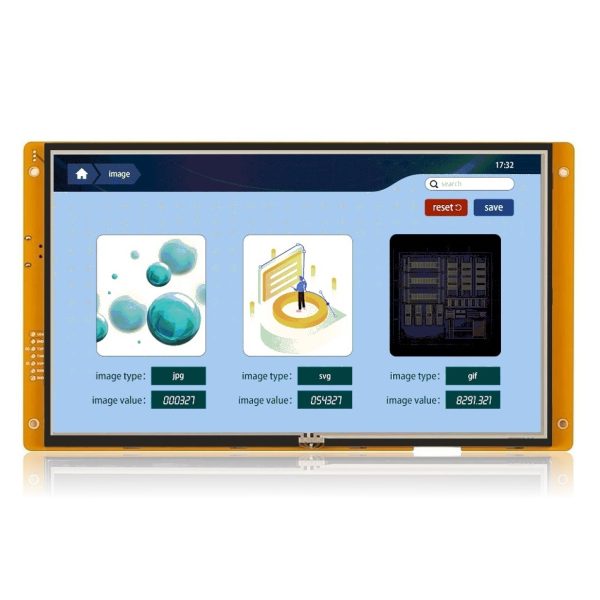在现代工业测试环境中,精度、可靠性和效率至关重要。无论是测量关键参数、分析设备性能还是监控生产线,准确的数据采集都至关重要。一项关键技术正在改变工业测试领域,即薄膜晶体管显示屏(串口屏)与测试仪器的集成。这些先进显示屏不仅能提供清晰的实时数据可视化,还能提升用户交互体验、改善诊断功能并增强整体系统性能。

仪器TFT显示屏
本文将探讨适用于工业测试仪器的串口屏的重要性,重点介绍其特点、优势以及如何革新行业测试与质量控制的方式。此外,我们将探讨其他相关方面,如显示屏的耐用性、易用性以及与其他工业系统的集成性。
为何串口屏适用于工业测试仪器?
薄膜晶体管(TFT)显示屏因其卓越的图像质量、响应速度和耐用性,被广泛应用于包括测试仪器在内的众多工业领域。这些显示屏基于薄膜晶体管技术原理,可实现精准的像素控制和高分辨率彩色显示。当集成到工业测试仪器中时,串口屏能带来一系列优势,显著提升性能和用户体验。
串口屏适用于工业测试应用的主要原因包括高分辨率、宽视角、低功耗和先进功能。让我们深入探讨使串口屏成为测试仪器首选的具体优势。
工业测试仪器用串口屏的关键特性
1. 高分辨率实现精准数据呈现
串口屏的一大突出特点是其高分辨率。这些显示屏能够以极高的细节和清晰度展示复杂数据、图表和诊断信息。在工业测试领域,精度至关重要,清晰准确的视觉呈现对于正确分析和决策至关重要。
例如,在监控测试结果或读取温度、压力或电压等测量值时,操作人员可以清晰地查看数值、趋势和系统状态。显示高分辨率图表或图表的能力提升了测试数据的解读,从而使操作人员能够做出更明智的决策并更快地解决问题。
此外,高分辨率通过减少模糊性提升了用户体验。操作人员无需再解读模糊的读数或猜测显示的数据,这有助于防止错误并提高整体生产效率。
2. 宽视角设计,适应多样化操作
工业测试环境通常规模庞大且节奏快速,多名操作员需同时工作。串口屏采用宽视角设计,即使从不同位置和角度观看,也能呈现清晰画面。这一特性在生产线上或实验室等场景尤为重要,因多用户需同时查看屏幕上的数据。
宽视角确保数据始终清晰可读,即使操作人员未正对屏幕。无论是地面安装的仪器还是手持测试设备,宽视角设计都能让操作人员从任意位置快速获取信息,从而提升整体操作效率。
3. 实时数据可视化与交互性
在工业测试中,实时数据可视化对于监控机械、设备或系统的运行性能至关重要。串口屏可动态呈现采集的测试数据,使操作员能够基于最新信息立即做出决策。
此外,现代串口屏通常配备触摸屏功能,允许操作员直接与仪器交互。通过直观的触摸界面,用户可选择不同参数、调整测试设置、放大特定数据点或触发系统警报——所有这些功能均有助于优化测试流程。
例如,监控电机输出的一名技术人员可直接在串口屏上快速调整测试参数或查看历史测试数据。这种交互能力不仅简化了测试流程,还使故障排查更加快速高效。
4. 工业环境下的耐用性与 robustness
在工业环境中,测试仪器必须承受灰尘、潮湿、温度波动和振动等严苛条件。专为工业应用设计的串口屏通常采用坚固耐用的结构。这些显示屏采用高品质材料制成,能够承受工厂、实验室和测试区域的物理需求。
例如,IP防护等级的串口屏常用于暴露在潮湿或多尘环境中的测试仪器。这些显示屏设计旨在防止灰尘、水和其他污染物损坏屏幕,确保显示屏在恶劣环境中仍能可靠运行。
此外,工业级串口屏通常配备抗震和防眩光功能,确保屏幕在各种运行条件下保持功能正常且易于阅读。
5. 长久使用下的能效
工业测试仪器常需连续运行数小时甚至更长时间,因此能效至关重要。基于低功耗技术的串口屏具备卓越的能效表现,可显著降低测试设备的整体能耗。
在低功耗运行时仍能提供高画质显示,意味着配备串口屏的测试仪器可更长时间运行,无需频繁充电或停机。这在远程测试等应用中尤为重要,因为仪器可能需要在无直接电源供应的情况下自主运行较长时间。
工业测试仪器中使用串口屏的优势
1. 提升用户体验与效率
串口屏显著提升了工业测试应用中的用户体验。其直观的界面、清晰的数据呈现和交互式控制使操作人员更容易理解复杂的测试结果并迅速采取行动。
测试流程的效率也得到提升,因为操作人员可以快速浏览不同数据集、调整参数并获得即时反馈。这种易用性降低了新用户的学习曲线,减少了重复任务的时间,使工作人员能够专注于更重要的任务。
此外,触摸屏功能允许用户无需依赖物理按钮或手动输入即可控制测试仪器并访问诊断信息,进一步简化操作流程。
2. 提升准确性和决策质量
凭借串口屏提供的详细数据,操作员更容易发现测试结果中的细微差异,例如电压或压力的小幅波动。这些细节在使用过时或低分辨率显示屏时容易被忽视。
通过提供更清晰的视觉呈现和更准确的数据表示,串口屏有助于工业测试中的更好决策。操作员可快速识别异常情况、检测系统故障并采取必要措施以维持最佳性能。
3. 实时诊断与预防性维护
串口屏在实时诊断中也至关重要。当测试仪器收集数据时,系统可标记需要关注的潜在问题或异常。通过在屏幕上持续显示数据和诊断反馈,操作人员可在故障发生前采取预防措施。
例如,若某一参数在测试过程中超过预设阈值,串口屏可通过屏幕警告提醒操作员,实现及时干预。早期问题检测可降低昂贵维修成本并减少计划外停机时间,从而使整个测试流程更加可靠且成本效益更高。
4. 与其他工业系统无缝集成
串口屏在工业测试仪器中的另一大优势在于其能够无缝集成其他工业系统。许多现代测试仪器设计时便支持与工业控制系统、SCADA(监督控制与数据采集)系统或楼宇管理系统(BMS)等系统通信。串口屏可作为操作员监控这些集成系统状态的接口。
例如,用于监控生产线性能的工业测试仪器可与工厂中央控制系统通信。串口屏可同时显示仪器和控制系统的实时数据,使操作员能够同时监控多个参数。
5. 定制化和可扩展性以适应不同应用
工业测试仪器通常需要针对特定应用场景进行定制,例如测试不同类型的机械设备或工艺流程。串口屏提供高度的定制化,可将界面适配于各种应用需求。
例如,显示屏可配置为显示不同单位的测量值、包含多个图表或数据表,甚至突出显示需要特别关注的数据点。这种定制化确保测试仪器能满足操作人员或行业的特定需求。
此外,随着行业的发展和新测试要求的出现,串口屏提供可扩展性。无需对仪器进行重大硬件改动,即可在显示屏上添加额外功能、参数或整个数据集。
串口屏如何助力工业测试的未来
随着工业领域的持续发展,TFT显示技术将在工业测试的未来中发挥更加重要的作用。随着对智能制造、工业4.0和物联网(IoT)集成的需求不断增长,配备先进串口屏的测试仪器将持续演进。
例如,通过串口屏,可实现云端数据与AI驱动分析在测试仪器中的集成。操作人员可通过显示界面查看预测分析结果、接收自动化建议,甚至远程监控全球系统。
结论
适合工业测试仪器的串口屏的集成带来了诸多优势,包括高分辨率、耐用性、实时数据可视化以及与其他系统无缝集成。这些显示屏显著提升了测试过程,使操作员能够更高效、更准确地监控、诊断和分析数据。
随着工业环境日益复杂,测试仪器对先进显示技术的需求将持续增长。串口屏的性能为满足这一需求奠定了坚实基础,推动工业测试向更高精度、可靠性和生产力方向发展。
将串口屏集成到工业测试仪器中,不仅仅是硬件升级——而是变革行业进行测试、质量控制和系统优化的方式。